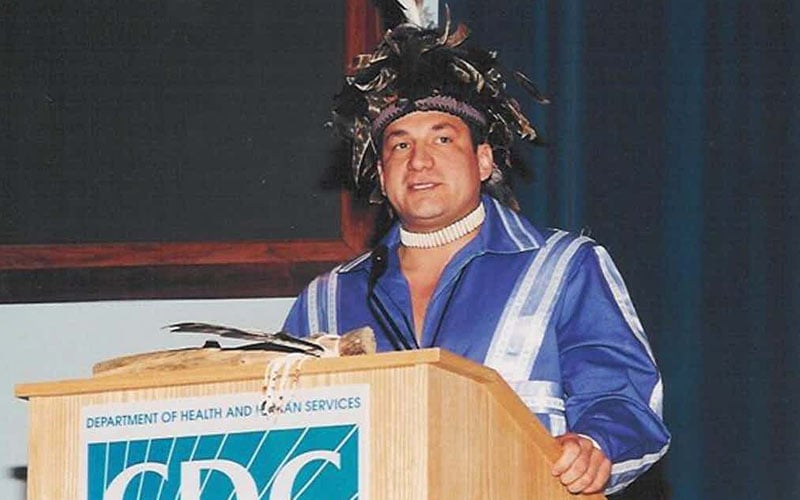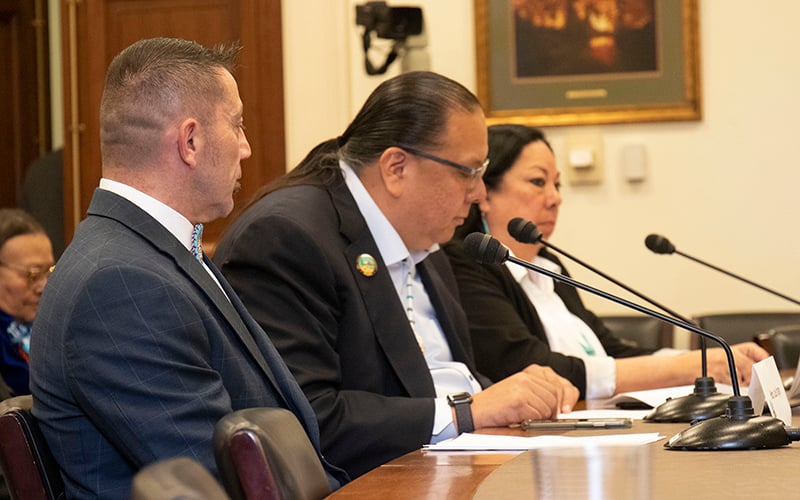
“I can easily transfer that virus over to you,” said Dean Seneca, who works with the Centers for Disease Control’s Office for State, Tribal, Local and Territorial Support. “And that’s very unique with this virus.” (Photo courtesy of Dean Seneca)
WASHINGTON – Dean Seneca didn’t mince words after the Centers of Disease Control and Prevention’s recent “damaging news” about the spread of the novel coronavirus that has killed more than 3,000 people worldwide, including nine in Washington state.
“I want to make sure that I stated that tribes are not prepared for the coronavirus,” he texted Indian Country Today a day after an interview in which he was more cautious.
“I don’t think that we are as prepared as we should be,” Seneca – who has worked more than 18 years in the Centers for Disease Control’s Office for State, Tribal, Local and Territorial Support – had said in the interview.
What changed overnight? Two things: The infection rate and the length of time an infected person shows no sign of the disease.
The first example was the Diamond Princess cruise ship incident in which one passenger on board, as well as one who had left the ship earlier, tested positive for COVID-19. A two-week quarantine resulted in 45 passengers becoming infected.
Seneca said health officials now know “that people will have this virus, not show symptoms and still be able to transmit the virus. That is scary.”
Viruses usually are contagious at the peak, he said. For example, in the first two days you’re slowing getting sick and on the third day, you’re at a height of an infection. People you come into contact with can get sick. It’s for sure.
Concerns with proper surveillance
But someone carrying coronavirus can walk around from Day 1 to Day 7 and show no symptoms.
“That’s very unique with this virus,” Seneca said, “compared to other similar infectious disease flulike agents.”
Seneca, who’s executive director of Seneca Scientific Solutions in Cattaraugus, New York, has been on the frontlines of fighting epidemics like polio in Ethiopia and Ebola, and he was a first responder to the H1N1 influenza virus. A member of the Seneca Nation, he also holds a master’s degree in public health from the University of Hawaii at Manoa.
That knowledge and experience has him concerned about Indian Country’s preparedness for COVID-19, which has stricken close to 100 Americans.
The 12 tribal epidemiology centers “don’t have the capacity to do good surveillance for the tribes regarding this,” said Seneca, who used to work for the Great Lakes Inter-Tribal Epidemiology Center.
“We don’t have links with our tribal health departments and/or state health departments in order to share data or real-time incidence, prevalence and any kind of mortality data or information related to this,” he said. “Our systems are just not in place in order to do good active surveillance.”
According to the World Health Organization, active surveillance allows public health officials to continuously and systematically collect, analyze and interpret the data needed to plan, implement and evaluate public health practices.
With 574 federally-recognized tribes, 12 epidemiology centers, a severely underfunded Indian Health Service, more than 320 reservations and 5.2 million American Indians and Alaska Natives, there is a significant opportunity for imperfection and chaos when it comes to public health emergencies.
The Navajo Nation on Thursday established a COVID-19 preparedness team that includes the offices of President Jonathan Nez and Vice President Myron Lizer, the Department of Health, the divisions of Public Safety and Social Services, the Department of Emergency Management, the Department of Diné Education, the U.S. Indian Health Service, Bureau of Indian Affairs and the Bureau of Indian Education.
‘We really are not ready for it now’
Nez wants to bring in community health representatives to educate tribal elders.
Nez and Dr. Jill Jim, executive director of the Navajo Department of Health, recently gave updates and prevention tips during an appearance on KTNN radio in Window Rock, the nation’s capital.
“There are no cases of the coronavirus on the Navajo Nation,” Nez said, “but this is a very serious health concern and it’s vital that we continue to provide information with everyone, including students, elderly and community members.”
The Inter Tribal Council of Arizona and the California Tribal Epidemiology Centers have been disseminating information to tribes within their states. California also is contingency planning and developing scenario-based exercises for their tribal health clinics. The Rocky Mountain Tribal Epidemiology Center sends out COVID-19 documents from the CDC and “daily key points” to the tribal health directors.
Seneca said tribes need the resources to tackle the threat head-on.
“The other is that our health care systems are really not in place, nor do we have experts, as physicians and nurses that know or are familiar with this kind of foreign virus,” he said.
“I just wanted to make it clear that we are not ready for this. We really are not ready for it now.”
The National Council of Urban Indian Health sent a letter to Congress on Feb. 28, urging lawmakers to honor the trust responsibility to urban Indians. The council asked Congress to include “urban Indian organizations” when approving emergency funding to prevent and treat COVID-19. It also requested “at the very least $94 million for emergency funding and health education/promotion” for urban Indian organizations.
In a March 2 press release, Francys Crevier, executive director of the National Council of Urban Indian Health, requested funds for the council’s 41 urban Indian organizations in 22 states.
“The U.S. government cannot allow (urban Indian organization) patients to die during a COVID-19 outbreak due to unavailability of critical services. UIOs operate on such low funding margins that interruptions in daily operations … have dire effects and have been forced to close entirely.”
Urban Indian organizations receive their funding from one source: Indian Health Service, which has one budget line for the 41 urban Indian organizations. Seventy percent of the American Indian and Alaska Native population resides in urban areas, according to the 2010 Census.
Kevin English directs the Southwest Tribal Epidemiology Center in Albuquerque, which serves 27 tribes in New Mexico and Colorado.
Emphasizing education
English said the center doesn’t have access to state health departments data that would allow it to track the respiratory virus in real time. However, tribes can request data from the state, and the center is to make sure they get that data.
“States do typically share (American Indian/Alaska Native) data with us at the county level, which we can then utilize to identify hotspots, target outreach efforts, and monitor over time,” English said. “This type of data sharing may vary by state and (tribal epidemiology center).”
The center is using CDC educational materials to educate tribal leaders, members and health care providers about COVID-19.
That’s also the case in Oregon, which reported its third presumptive positive case of the virus. The Confederated Tribes of the Umatilla Indian Reservation, near the Washington state line, confirmed an employee at the tribe’s casino has the disease.
Video by Madison LaBerge/ Cronkite NewsNine deaths from COVID-19 already have been reported in Washington. Victoria Warren-Mears, director of the Northwest Tribal Epidemiology Center, which serves Oregon, Washington and Idaho, is confident tribes in her state, Oregon, are ready for the virus.
“The tribes do have preparedness planning,” she said. “Anytime there’s something new that comes up, though, there’s definitely some feeling out of what strategies are the best for tribes and for just the general population to deal with that. And so I think in general, tribes are fairly well-prepared.”
The Confederated Tribes of the Umatilla Indian Reservation were prepared, and their timing was good.
Tribal spokesman Chuck Sams said the tribes were part of conference calls Friday and Saturday with the CDC, the Oregon Health Authority, all 36 counties and nine tribes. They wanted to lay out potential scenarios and establish an emergency management team.
The tribes in 2018 adopted an approved public health emergency plan for epidemics and pandemics, and it had an agreement with its local clinic with support from their county.
“And the plan paid off this morning,” Sams said. “We’ve been able to do tabletop exercises to prepare for it.”
At 7 a.m. Monday, Gov. Kate Brown called to inform tribal authorities that a worker at the Wildhorse Resort and Casino had contracted COVID-19. By noon, the resort and casino were closed, as were the tribes’ Nixyaawii Community School, Head Start program, day care and senior centers. In addition, community events on the Umatilla Reservation were canceled for the week.
Future challenges and solutions
Dr. Walter Hollow of the Puyallup Tribal Health Authority in Tacoma, Washington, advises tribes that are short on resources to form a planning committee to discuss steps to take if the coronavirus enters their communities. They should focus on containing the virus or moving on to treatment in isolation, he said.
“That would be up to each tribe. And, of course, the tribes that are run by the Indian Health Service, they’re going to have access to an epidemiologist, which will be very helpful,” Hollow said. “Contracting tribes usually don’t have access to an epidemiology person unless they work closely with the health department in their county.”
That’s the challenge of the 12 tribal epidemiology centers across the country: There’s no shared database.
“Unfortunately, yes, there’s probably no one place that’s a clearinghouse for what kind of data each epicenter has access to,” said Warren-Mears of the Northwest Tribal Epidemiology Center. “I wish there was, but at this point in time we all have different kinds of access based on our partnerships with our states that we serve or the states that we’re located in and the tribes we serve.”
Seneca said tribal sovereignty also can be used to battle the virus.
“It’s really the tribe’s responsibility to exercise its public health authority,” he said. “It shouldn’t have to wait for the Indian Health Service or the Centers for Disease Control to make active measures that this virus is in their community or not.”
An example of a tribe exercising its public health authority is not letting anybody within its borders if the virus is prevalent outside the tribal communities.
If the federal government or Indian Health Service were to isolate a tribe or block a road, Seneca said, the tribe has a right to say, “We need this road for our resources and services.”
“What I’m saying is that before the federal government puts any kind of public health restrictions or exercise in public health authority, it needs to consult with tribes on a government to government basis,” he said. “Let’s say there is a pandemic and it does hit the United States, that does hit with the severity as it is in other countries. This will be the big issue for Indian Country.
“Where does public health authority lie and what is our sovereign right to exercise tribal sovereignty?”

